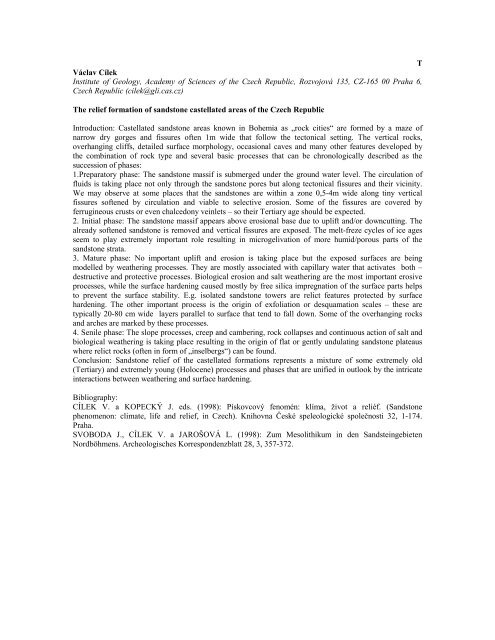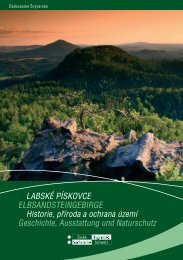ABSTRACT BOOK Sandstone Landscapes ... - Sandstones.org
ABSTRACT BOOK Sandstone Landscapes ... - Sandstones.org
ABSTRACT BOOK Sandstone Landscapes ... - Sandstones.org
You also want an ePaper? Increase the reach of your titles
YUMPU automatically turns print PDFs into web optimized ePapers that Google loves.
TVáclav CílekInstitute of Geology, Academy of Sciences of the Czech Republic, Rozvojová 135, CZ-165 00 Praha 6,Czech Republic (cilek@gli.cas.cz)The relief formation of sandstone castellated areas of the Czech RepublicIntroduction: Castellated sandstone areas known in Bohemia as „rock cities“ are formed by a maze ofnarrow dry g<strong>org</strong>es and fissures often 1m wide that follow the tectonical setting. The vertical rocks,overhanging cliffs, detailed surface morphology, occasional caves and many other features developed bythe combination of rock type and several basic processes that can be chronologically described as thesuccession of phases:1.Preparatory phase: The sandstone massif is submerged under the ground water level. The circulation offluids is taking place not only through the sandstone pores but along tectonical fissures and their vicinity.We may observe at some places that the sandstones are within a zone 0,5-4m wide along tiny verticalfissures softened by circulation and viable to selective erosion. Some of the fissures are covered byferrugineous crusts or even chalcedony veinlets – so their Tertiary age should be expected.2. Initial phase: The sandstone massif appears above erosional base due to uplift and/or downcutting. Thealready softened sandstone is removed and vertical fissures are exposed. The melt-freze cycles of ice agesseem to play extremely important role resulting in microgelivation of more humid/porous parts of thesandstone strata.3. Mature phase: No important uplift and erosion is taking place but the exposed surfaces are beingmodelled by weathering processes. They are mostly associated with capillary water that activates both –destructive and protective processes. Biological erosion and salt weathering are the most important erosiveprocesses, while the surface hardening caused mostly by free silica impregnation of the surface parts helpsto prevent the surface stability. E.g. isolated sandstone towers are relict features protected by surfacehardening. The other important process is the origin of exfoliation or desquamation scales – these aretypically 20-80 cm wide layers parallel to surface that tend to fall down. Some of the overhanging rocksand arches are marked by these processes.4. Senile phase: The slope processes, creep and cambering, rock collapses and continuous action of salt andbiological weathering is taking place resulting in the origin of flat or gently undulating sandstone plateauswhere relict rocks (often in form of „inselbergs“) can be found.Conclusion: <strong>Sandstone</strong> relief of the castellated formations represents a mixture of some extremely old(Tertiary) and extremely young (Holocene) processes and phases that are unified in outlook by the intricateinteractions between weathering and surface hardening.Bibliography:CÍLEK V. a KOPECKÝ J. eds. (1998): Pískovcový fenomén: klíma, život a reliéf. (<strong>Sandstone</strong>phenomenon: climate, life and relief, in Czech). Knihovna České speleologické společnosti 32, 1-174.Praha.SVOBODA J., CÍLEK V. a JAROŠOVÁ L. (1998): Zum Mesolithikum in den SandsteingebietenNordböhmens. Archeologisches Korrespondenzblatt 28, 3, 357-372.




